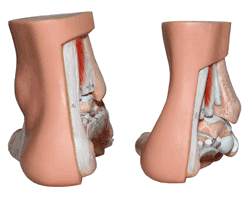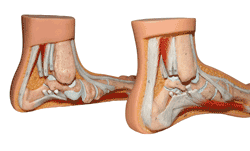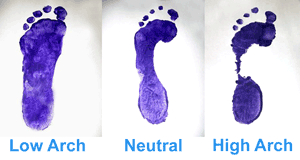Reduced foot function is classically as a result of genetics, injury or disease.
Further interest : What is the cause of my Pain?

Flat feet can feel painful or cause knee or back pain, giving increased muscular fatigue as a result of your body compensating for feet that have lost their springiness and natural elasticity.
During walking, excessive flattening movement of your hind-foot (over-pronation) creates inefficiency as you propel forward over your mid-foot and lever off your toes. This causes pain and increases the amount of energy lost, impacting heavily on walking endurance.
Do you have a low arch or a high arched foot? Look at your footprint to find out.
- Place a large piece of paper or cardboard on a flat surface.
- Dip the bottom of your foot in water. Place your foot on the cardboard and step as you would if you were walking normally.
- Decide if you have flat feet. If you have a flat foot, your footprint will show almost no visible arch from the toe to the heel. Your footprint may even show signs of an outward curve.
- Figure out if your foot has a normal arch. A normal footprint will have a minor arch to it, but the inward arch will be no more than 20mm at the greatest point.
- Find out if your foot has a high arch. If the middle of your footprint is very skinny, this means you have a high arch.
- Decide what kind of shoes to buy. If you are flat-footed, purchase shoes that help with stability. If you have a high arch in your foot, buy flexible shoes with a soft mid-sole, avoid slip on shoes. If your foot has a normal arch, avoid shoes that are designed for flat feet or for high arches.
Low arched feet are easily seen as a wide footprint and are normally too flexible and over mobile, requiring strong shoes for comfort and stability. Muscle strengthening can be a useful way of counteracting some of these problems but is much more effective technique to use when you are a child and your body is still developing.
High arched feet are quite different allowing very little contact with the ground in the instep of your foot. They are typically quite rigid and show reduced ranges of motion with too much pressure being taken at the ball of the foot. Achilles and hamstrings are normally quite tight, so stretching is really important – before and after exercise.
Try this out for yourself

Stand up and watch as you roll your weight to the outside of your feet, then relax and allow your feet to roll back on the inside border of your feet.
Notice the movement of your knee and hips as you do this. When you walk on feet that are too flat it increases the normal internal rotation of your knees which then turns your hips in too much, making your pelvis tip forward. This in turn increases your lumbar curve (the curve in the small of your back) and makes your bum stick out!
Alignment changes like this are normally fine when we are young and supple, but when we grow ‘more mature’ (over 30) our bodies progressively become more rigid and less forgiving and we can quickly pick up injuries, or find that an old injury recurs.
By understanding your Bio-mechanics, an Orthotist can design Orthotic Insoles to correct unnatural joint alignment, protecting you from injuries by placing your limbs in the optimal position.
If you do have an injury, look carefully at your posture as it may be contributing to your problem or be responsible to the delay to your healing.
Hard skin or calluses are formed as a result of shear forces slipping and tearing your skin repetitively. Untreated this will build up continually causing discomfort and reduced walking ability.
Painful bony prominences under the fore-foot cause significant discomfort when wearing heeled footwear or when walking on thin soled fashionable footwear.
Claw or hammer toes, although very common, can in an uncorrected state be very difficult to accommodate within footwear due to pressure on the top of the joints of the toes.
Leg length discrepancies can give rise to serious lumbar back pain that is typically felt to be single sided in origin arising deep on one side of the small of your back. This frequently occurring problem can remain unnoticed during your youthful flexible years and come to notice during the maturing or stiffening of the musculo-skeletal system.
Bunions although initially pain free can often create difficulties in finding appropriate footwear and when allowed to develop can be responsible for pain in the fore-foot. This can become very acute when combined with a deterioration in the function of the big toe (Hallux Valgus, Hallux rigidus/limitus). While these are often progressive deteriorating disorders, good fitting orthotic insoles can slow their development by reducing the forces applied to the affected joint.


Pingback: Martin Bell | Berkeley Centre Health